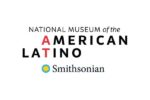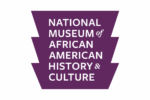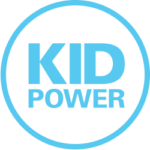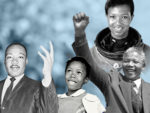Diversity, Equality, Cultural Competency
Explore Black History Month with your students using lessons, podcasts, activities, and primary sources curated by Smithsonian History Explorer.
Examine collections of the Museum’s key resources on major themes in American history and social studies teaching. Additional resources can be found in the main search areas of their website.
“Separate but equal” laws segregated society and culture in the United States for the first half of the 20th century. After World War II, the tide began to turn and one place where Americans saw a change was in professional sports. In 1946, African American baseball player and military veteran Jackie Robinson became the first black man to play on a white team in a segregated league. With support from his wife and community, he broke that “color barrier” during spring training in Daytona Beach, Florida, at the City Island Ballpark.
Robinson earned the title Rookie of the Year in 1947, played in the World Series in 1955, and was a passionate Civil Rights activist when his athletic career ended. The “City Island Ballpark” is listed on the National Register of Historic Places for its association with him and renamed in his honor. This lesson explores Jackie Robinson’s life and the events of 1946, racism and “Jim Crow,” pop culture’s influence on a nation of laws, and the historic beachfront ballpark.
This lesson can be used in U.S. history, social studies, and other curricula that examine African American history and civil rights in the United States following World War II.
Commemorate Black History Month in your classroom with lesson plans and resources that cover topics ranging from civil rights events to discussions about race in current events. These lessons are appropriate for history, ELA and social studies classrooms, and include resources for students in middle or high school.
The Scholastic Storyworks archives bring you some of our most beloved stories for Black History Month, from a powerful play about a kid who led a series of sit-down strikes to a gripping nonfiction article about the co-discoverer of the North Pole. We hope you enjoy sharing these Black stories with your students.
This Dia de los Muertos Lesson Plan was created by Vanderbilt University’s Center for Latin American Studies. This includes a comprehensive learning plan with art projects that students can create to supplement their learning. This lesson plan was originally written for 5th grade, but can be adapted for grades 3-12.
Content Learning Target: Students will be able to understand the cultural significance of Día de los Muertos traditions.
Language Learning Target: Students will be able to define Día de los Muertos and explain how the holiday honors the deceased.
El Día de los Muertos (Day of the Dead) is a day of celebration, particularly for the people in Mexico and Central America, and for many Mexican Americans in the United States. It is a day to honor and commemorate the lives of the dearly departed and to welcome the return of their spirits.
Learn all about this cultural holiday with free resources from the Smithsonian National Museum of the American Latino, including a Day of the Dead learning kit, virtual exhibitions, music, stories, videos, and more.
Juneteenth is a time for celebration and reflection with the whole family. For young children, the abstract concept of freedom and the hard history of slavery can be challenging to grasp. NMAAHC’s early childhood education team offers the following resources to support young children’s understanding and celebration of Juneteenth: a guide on how to talk about slavery and freedom in age appropriate ways, an activity to inspire hope and activism, and a children’s book and online resources list.
June 19, or Juneteenth, is a holiday that commemorates the day that Texas, the last Confederate state, learned about the Emancipation Proclamation — marking the end of slavery in the United States in 1865.
But as University of Pittsburgh historian Alaina Roberts notes, it’s important to remember that the emancipation of slaves didn’t actually happen in one fell swoop. Here’s information about talking to children about Juneteenth and why it is important to do so.
Kid Power is an interactive video platform for students in grades Kindergarten through 8th. Kid Power combines philanthropy and fun with mental health, social-emotional learning (SEL), child rights, and equity and access for all students.
Traumatic events do not exist in a vacuum. Like other social phenomena, they should be understood within the social and cultural context in which they occur.
Native Land Digital strives to create and foster conversations about the history of colonialism, Indigenous ways of knowing, and settler-Indigenous relations, through educational resources such as our map and Territory Acknowledgement Guide. We strive to go beyond old ways of talking about Indigenous people and to develop a platform where Indigenous communities can represent themselves and their histories on their own terms. In doing so, Native Land Digital creates spaces where non-Indigenous people can be invited and challenged to learn more about the lands they inhabit, the history of those lands, and how to actively be part of a better future going forward together.
Bring the celebration of Black History Month into your classroom with these activities, lesson plans, book resources, and interactive histories. Choose from several activities surrounding African American icons, slavery, the Civil Rights Movement, schools and integration, music and arts, and more.










